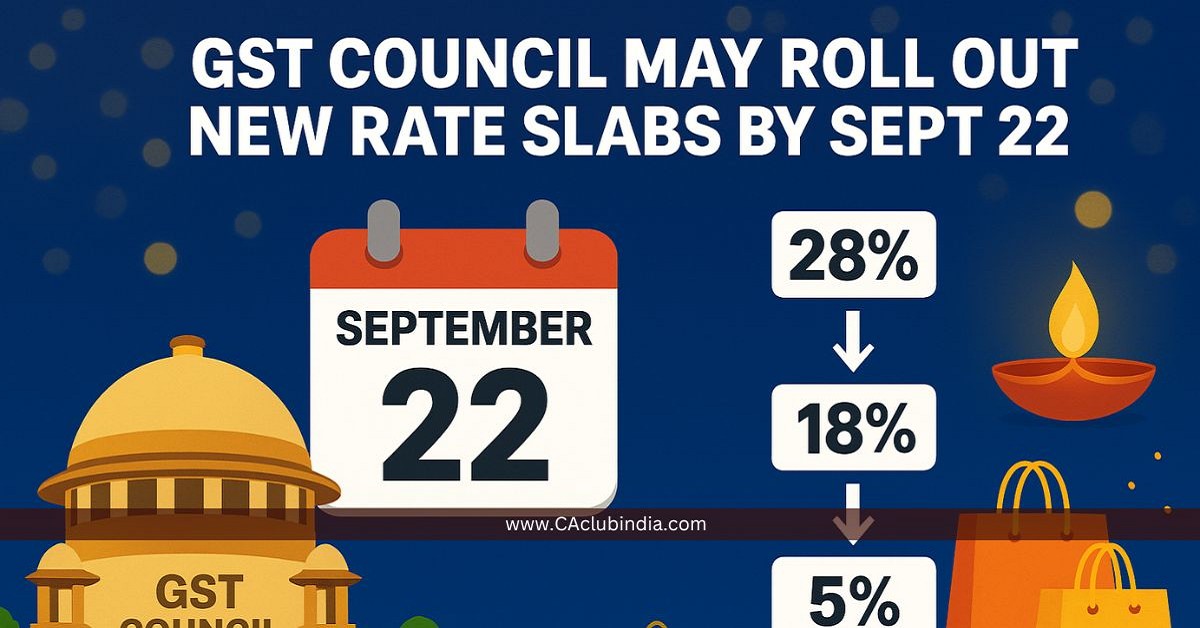According to sources, the GST Council, chaired by Finance Minister Nirmala Sitharaman, is expected to introduce a new set of GST rate slabs around September 22, 2025. The move, likely to coincide with the Navratri festive season, aims to boost consumption and revive demand across sectors.
According to a report, the Centre is keen on rolling out GST cuts at the earliest and may urge the Council to approve rate changes with immediate effect, though a final decision is pending.

Key GST Council Meeting on September 3-4
The GST Council will convene in New Delhi on September 3-4 to deliberate on the Centre's proposal for a simplified two-rate GST structure. Sources indicate that notifications on the revised rates could be issued within five to seven days after the Council's decision, paving the way for a rollout before the festive shopping season picks up momentum.
The Group of Ministers (GoM) on rate rationalisation, compensation cess and insurance taxation met earlier this week and in principle, endorsed the Centre's proposal.
From Four Slabs to Two: GST 2.0
Under the proposed reforms, India would transition from the current four-tier GST structure of 5%, 12%, 18%, and 28% to a simplified two-slab system:
- 5% for 'merit goods and services'
- 18% for 'standard goods and services'
In addition, a 40% rate is being considered for luxury and sin goods such as ultra-premium cars. Certain labour-intensive sectors may continue to enjoy concessional rates as low as 0.1%, 0.3%, or 0.5% to support employment.
Government's Reform Push: GST 2.0
The changes are part of the Centre's broader GST 2.0 reform package, announced by Prime Minister Narendra Modi during his 79th Independence Day address. Modi described GST as one of India's most transformative reforms since its launch in 2017 and stressed the need for rationalisation to provide relief to the common man, farmers, MSMEs and the middle class.
Finance Minister Sitharaman has echoed this vision, stating that the new GST regime would strengthen India's manufacturing sector, provide relief to small businesses, and contribute to the goal of building an Atmanirbhar Bharat.
Insurance Premiums Likely to Get Relief
Another major proposal under discussion is the exemption of GST on health and life insurance premiums for individuals and families. At present, such premiums attract 18% GST.
Bihar Deputy CM Samrat Choudhary, who heads the GoM on insurance taxation, confirmed that the Centre has recommended an exemption, though some states have expressed reservations. "The Centre's proposal is clear that the insurance sector's individual and family policies should be exempt from GST. This has been discussed and the GoM report will be presented to the Council," Choudhary said.
The panel includes finance ministers and representatives from 13 states, including Uttar Pradesh, West Bengal, Karnataka, Kerala and Tamil Nadu. A final report is expected to be submitted to the GST Council by October-end.
What Lies Ahead
If the GST Council approves the proposals in its September 3-4 meeting, the revised tax structure may be implemented as early as late September 2025. Experts believe that timely rate cuts ahead of the festive season could stimulate consumption, ease costs for taxpayers, and boost revenues through higher demand.
The Council's decisions will be closely watched, as they are set to shape the future of India's indirect tax regime and provide much-needed relief to households and businesses.







 CAclubindia
CAclubindia
